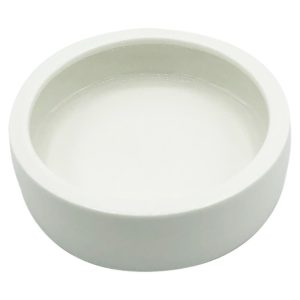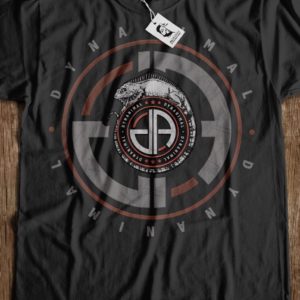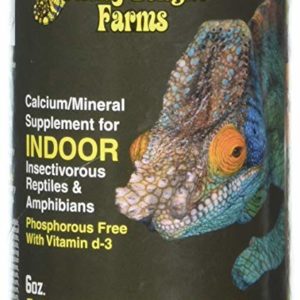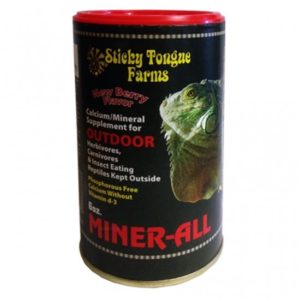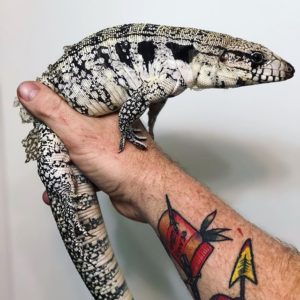 Tegu Care
Tegu Care
Argentine Tegus of the genus Salvator are large lizards that hail from South America; they can grow up to 60” and live 15-25 years in captivity. Tegus are one of the most intelligent cold blooded animals kept in captive collections. Tegus or “gus” are often referred to as scaled puppies, it is not uncommon for them to become extremely tame with constant keeper interaction. Even with minimal socialization, tegus tend to be very docile. This care sheet will seek to provide basic knowledge of how to keep your tegu in tip top shape and explore alternative feeding options that have worked very well for us here at DynAnimal.
Housing
Being larger lizards, tegus do require space! A large secure enclosure that has enough surface area to allow for a proper thermal gradient, the animal to completely turn around in, adequate substrate and offer a couple hiding options is a must for a full grown tegu. Baby tegus can start life in an enclosure as small as a 40 breeder (36”L x 18”W x 18”H) with a 36”L x 24”W x 18”H or slightly larger being ideal. Tegus grow rapidly and they will quickly outgrow a cage this size, and plans will need to be made to move them into a larger permanent enclosure soon.
Indoors the very minimum we recommend for an adult is 6’L x 3’W x 3’H, please keep in mind that this is the smallest an adult tegu should be kept in, and they will need to be allowed time out to exercise. Ideally an adult cage should be at least 8’L x 4’W x 4’H. Dependent on geographical location and the temperatures in your area, you may be able to keep tegus outdoors most, if not all year round as we do here at DynAnimal. We house our tegus here in Texas in variety of cages for different life stages; including 48”L X 24”W x 24”H baby enclosures, 48”L x 48”W x 48”H grow out cages, and 10’L x 5’W x 6’H walk-in adult caging. Regardless of what type of enclosure you use, make sure that it is setup with the needs of the animal outlined below.
For new keepers we do not recommend keeping more than one animal together to avoid possible fighting or accidents. Tegus do not need another scaled companion to keep them company. While some people do “free-roam” tegus and allow them to have run of the house, we advocate against and preach that your tegu be kept in a controlled environment to ensure the proper temps, humidity and UVB requirements are met.
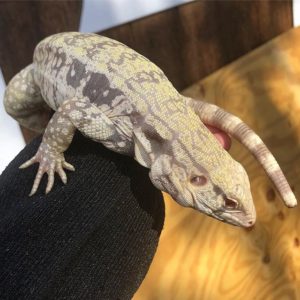 Heating
Heating
Tegus, as with many reptiles do require a thermal gradient. We suggest an ambient temperature between 80°f on the “cool” end, up to 95°f on the “hot” side. The “hot” side should include a place to bask. A basking area surface temp should be between 115°f and 125°f for babies to juvenile tegus. We have found the 120°f- 125°f range to be ideal for young animals. Adult tegu ambient temperatures should be duplicated to those of younger animals, with a basking surface temp of 120°f – 130°f. Remember that ambient and basking surface temps are not the same and attention should be given when setting up your enclosure as to how you accomplish these. You can use a variety of products to achieve the desired temps such as flood lights, MVB bulbs or ceramic heat emitters (CHE’s). CHE’s and halogen flood lights work great, they tend to emit more heat per watt than any reptile basking bulb, have a long lifespan and can be controlled via a dimmer or thermostat without shortening that life. Basking temps should be monitored via an infrared thermometer, while ambient temps and humidity are best measured with a digital thermometer / hygrometer.
Lighting
Tegus are diurnal (active during the daytime) animals requiring a 12 to 14 hour photoperiod. Tegus do need exposure to UVB and heat as a result of being a day loving reptile. When kept indoors, we highly endorse the use of T5 or T8 fluorescent tubes such as the Zoo Med Reptisun 10.0 for UVB and either PAR30 or PAR38 halogen flood lamps for heat. Since they are diurnal, tegus like light and the use of a halogen flood in correspondence to a fluorescent tube gives them a nice bright enclosure. Your setup will determine what style of bulbs you will need. For example: T5HO bulbs work well when placed on a screen top as screen lids tend to block roughly 30% of the UVB produced, they are also great in taller / or larger cages. NOTE: The UVB output of all types of reptile lamps diminishes over time. As a result, UVB bulbs need to be changed annually regardless if they are still producing visible light. T8 fluorescents should be replaced every six months while T5’s can go ten to twelve months.
Substrate
For substrate, DynaAnimal recommends the use of a sand / top soil /coco fiber mix, just coco fiber or cypress mulch. Our favorite here is the mix as it seems to work best all-around for a variety of animals without many of the negatives associated with other beddings. Tegus do require high humidity in the 70% to 90% range and proper substrate is imperative to support this. A depth of at least 4” should be maintained for babies while adults should be given 8” plus. Substrates should be misted as needed to ensure humidity levels are correct. Pay close attention to bedding moisture content and cage ventilation to safeguard animals from overly saturated substrate. This can cause several health issues such as open sores or loss of toes. You want to avoid pine, cedar or the like, as these can be toxic to reptiles. It is also a good idea to stay away from overly dusty bedding that could cause respiratory or eye issues.
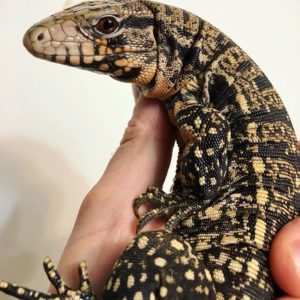 Shelter
Shelter
Hides can be provided a variety of ways. There are many companies out there that manufacture reptile specific shelters and almost any of them will work. Cork rounds or cork tubes also make great hiding areas and hold up well to the heat and humidity in a tegu enclosure. Plastic storage totes with an entrance cut in the side may also be used.
If you are having trouble keeping humidity high, a storage tote with a mix of moistened coco fiber and sphagnum make fantastic humid retreats. We recommend you provide at least two hides in an enclosure, one on the “cool” side and one on the “hot” side. You may use more than two if you would like, tegus enjoy the stimulation provided by décor and places to explore. Hide boxes should large enough your tegu can conceal its entire body and curl up in as well as withstand the environment you are placing them in.
Water
Being from a sub-tropical climate, tegus need constant access to fresh clean water. Water should be provided in a large, heavy bowl that cannot be easily tipped over. We have found that ceramic crocks work well with babies and juveniles, while larger rubber equine style feeder “pans” are great for adults. Whatever water dish you decide on, it should be large enough for your tegu to fully soak its entire body. Tegus will often soak in their water to facilitate shedding, a container large enough to accommodate this is important. Make sure any water containers are not too deep, making it difficult for them to get in and out of. It is not unusual for a tegu to defecate in their water bowl, make sure and check bowls daily.
Food
Tegus by nature are opportunistic omnivorous and thrive on a varied diet. Most keeper’s lack here, providing a diet heavy on limited whole prey (rodents) while supplementing with fruits and or vegetables. While whole prey items are good for your tegu and make a great base for their diet, variety is the spice of life. It is also not unusual for tegus to become obese when fed mainly rodents; this can severely shorten their lifespan. Below is a list of items we incorporate with great success into our tegu breeding program. Using the foods below our tegus have great body conformation, babies grow quickly and perfectly, while production has been remarkable.
Babies through juveniles
Repashy Grub Pie, Repashy Grubs and Fruit, Repashy Meat Pie V2, crickets, superworms, dubia, ground turkey, ground whole rabbit, tilapia, catfish, salmon, chicken hearts and gizzards, appropriate sized rodents, Mazuri Insectivore Diet, moistened high end grain free dog food (We use Performatrin Ultra and Solid Gold), eggs, berries, mango, papaya, plantain, banana, apples, squashes, sweet potato and green beans. Every once in a while we add collard greens or flax seed to the mix.
Sub adults through Adults
We feed older animals the same as younger tegus, but the Repashy and smaller rodents are replaced with quail, day old chicks, whole fish and rat pups.
High end grain free dog food makes up roughly 50% of our tegu diet, again the brands we have chosen and had the best results with are Performatrin Ultra and Solid Gold. Feeding dog food is a controversial matter for some and something we have been researching for many years. Being omnivorous animals, we have found that tegus do amazing on a premium dog food; there is no better researched omnivore diet in existence. Several other large scale breeders have also had continued success using a premium dog food brand. The brands we have chosen to feed here at DynAnimal were picked for their quality ingredients including whole meats, fruits and vegetables. Any and all uneaten food should be removed from the tegu’s enclosure daily.
When feeding tegus, make sure you are using a shallow non porous bowl, plate or similar item that is easily sanitized. To make maintenance quick and easy, we use paper plates for babies through juvenile animals and cafeteria trays for adults. The trays are large enough to provide plenty of space for a meal, and easy to clean.
We recommend that all whole prey be either thawed frozen or pre-killed to avoid possible injury to your tegu.
Please note that Red tegus tend require slightly more fruit and plant material than other types of tegus.
DynAnimal does sell the Repashy products, click below to shop.
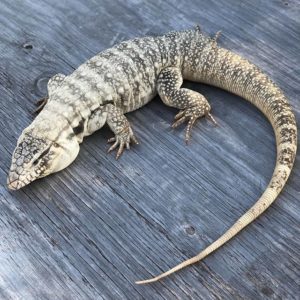 Vitamins
Vitamins
When feeding raw meats, insects, fruits and vegetables; animals kept indoors should be offered a calcium supplement containing D3 such as Repashy Calcium Plus LoD, Miner-All Indoor or Zoo Med Repti caclium D3. When using the Calcium Plus, there is no need to offer a separate vitamin supplement. For animals kept outdoors we use Zoo Med Repti Calcium no D3 and Miner-All Outdoor. We also offer Zoo Med Reptivite once a week for all reptiles kept outside. Commercially made food (Repashy, Mazuri or dog foods) and whole prey items do not need to be dusted with supplements. Stay away from any supplement brand that is higher than 20,000 IU in D3, while 10,000 IU or less is ideal. We have chosen the brands we offer because they are all 10,000 IU or under.
Cage Maintenance
Daily:
Remove any uneaten food items and spot clean substrate if needed. Check water bowl and change if needed.
Monthly:
Thoroughly clean the habitat, cage furnishings and all food bowls with a 10:1 water / ammonia solution. Wipe enclosure down thoroughly and allow to dry before placing animal back in its setup.
Inspect cage materials, lamp fixtures etc. for any damage.
Bedding should be changed as needed. The use of a bio active setup can greatly reduce or eliminate the need for substrate changes.

